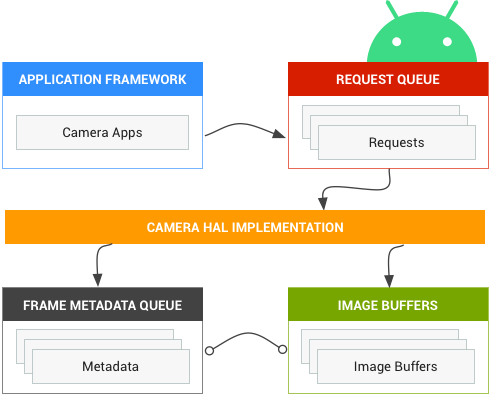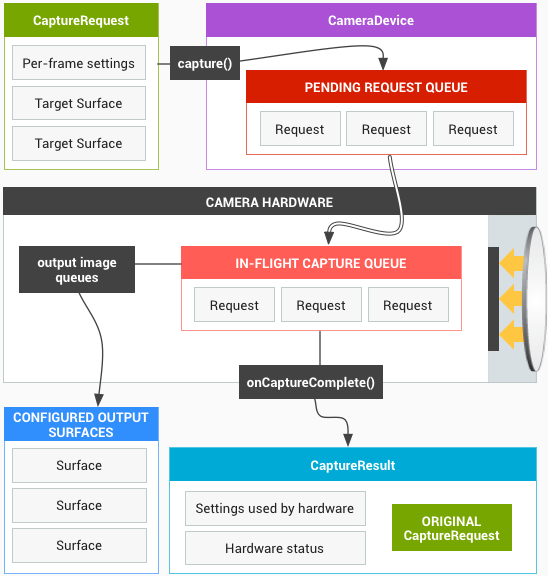备份下
First : F**K GFW !!!
Android's camera Hardware Abstraction Layer (HAL) connects the higher level camera framework APIs in android.hardware.Camera to your underlying camera driver and hardware. The latest version of Android introduces a new, underlying implementation of the camera stack. If you have previously developed a camera HAL module and driver for other versions of Android, be aware that there are significant changes in the camera pipeline.
Version 1 of the camera HAL is still supported for future releases of Android because many devices still rely on it. Implementing both HALs is also supported by the Android camera service, which is useful when you want to support a less capable front-facing camera with version 1 of the HAL and a more advanced back-facing camera with version 3 of the HAL. Version 2 was a stepping stone to version 3 and is not supported.
There is only one camera HAL module (with its own version number, currently 1, 2, or 2.1), which lists multiple independent camera devices that each have their own version. Camera module v2 or newer is required to support devices v2 or newer, and such camera modules can have a mix of camera device versions. This is what we mean when we say Android supports implementing both HALs.
Note: The new camera HAL is in active development and can change at any time. This document describes at a high level the design of the camera subsystem and omits many details. See Camera version support for our plans.
Overview
Version 1 of the camera subsystem was designed as a black box with high-level controls. Roughly speaking, the old subsystem has three operating modes:
- Preview
- Video Record
- Still Capture
Each mode has slightly different and overlapping capabilities. This made it hard to implement new types of features, such as burst mode, since it would fall between two of these modes.

Figure 1. Camera components
Version 3 enhancements
The aim of the Android Camera API redesign is to substantially increase the ability of applications to control the camera subsystem on Android devices while reorganizing the API to make it more efficient and maintainable.
The additional control makes it easier to build high-quality camera applications on Android devices that can operate reliably across multiple products while still using device-specific algorithms whenever possible to maximize quality and performance.
Version 3 of the camera subsystem structures the operation modes into a single unified view, which can be used to implement any of the previous modes and several others, such as burst mode. This results in better user control for focus and exposure and more post-processing, such as noise reduction, contrast and sharpening. Further, this simplified view makes it easier for application developers to use the camera's various functions.
The API models the camera subsystem as a pipeline that converts incoming requests for frame captures into frames, on a 1:1 basis. The requests encapsulate all configuration information about the capture and processing of a frame. This includes: resolution and pixel format; manual sensor, lens and flash control; 3A operating modes; RAW->YUV processing control; statistics generation; and so on.
In simple terms, the application framework requests a frame from the camera subsystem, and the camera subsystem returns results to an output stream. In addition, metadata that contains information such as color spaces and lens shading is generated for each set of results. The following sections and diagrams give you more detail about each component.
You can think of camera version 3 as a pipeline to camera version 1's one-way stream. It converts each capture request into one image captured by the sensor, which is processed into:
- A Result object with metadata about the capture.
- One to N buffers of image data, each into its own destination Surface.
The set of possible output Surfaces is preconfigured:
- Each Surface is a destination for a stream of image buffers of a fixed resolution.
- Only a small number of Surfaces can be configured as outputs at once (~3).
A request contains all desired capture settings and the list of output Surfaces to push image buffers into for this request (out of the total configured set). A request can be one-shot ( with capture() ), or it may be repeated indefinitely (with setRepeatingRequest() ). Captures have priority over repeating requests.

Figure 2. Camera core operation model
Supported version
Camera devices that support this version of the HAL must return CAMERA_DEVICE_API_VERSION_3_1 in camera_device_t.common.version and in camera_info_t.device_version (from camera_module_t.get_camera_info).
Camera modules that may contain version 3.1 devices must implement at least version 2.0 of the camera module interface (as defined by camera_module_t.common.module_api_version).
See camera_common.h for more versioning details.
Version history
1.0
Initial Android camera HAL (Android 4.0) [camera.h]:
- Converted from C++ CameraHardwareInterface abstraction layer.
- Supports android.hardware.Camera API.
2.0
Initial release of expanded-capability HAL (Android 4.2) [camera2.h]:
- Sufficient for implementing existing android.hardware.Camera API.
- Allows for ZSL queue in camera service layer
- Not tested for any new features such manual capture control, Bayer RAW capture, reprocessing of RAW data.
3.0
First revision of expanded-capability HAL:
- Major version change since the ABI is completely different. No change to the required hardware capabilities or operational model from 2.0.
- Reworked input request and stream queue interfaces: Framework calls into HAL with next request and stream buffers already dequeued. Sync framework support is included, necessary for efficient implementations.
- Moved triggers into requests, most notifications into results.
- Consolidated all callbacks into framework into one structure, and all setup methods into a single initialize() call.
- Made stream configuration into a single call to simplify stream management. Bidirectional streams replace STREAM_FROM_STREAM construct.
- Limited mode semantics for older/limited hardware devices.
3.1
Minor revision of expanded-capability HAL:
- configure_streams passes consumer usage flags to the HAL.
- flush call to drop all in-flight requests/buffers as fast as possible.
























 5099
5099

 被折叠的 条评论
为什么被折叠?
被折叠的 条评论
为什么被折叠?








